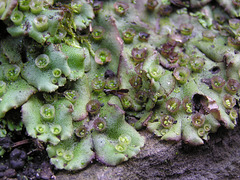Anne Elliott's photos with the keyword: Marchantiaceae
Pressia quadrata Liverwort
| 11 Aug 2013 |
|
|
|
I am SO tired after a wonderful day in the mountains today! I don't get out there very often at all, and certainly not as far as we went today, so it was an absolute treat! Friend Sandy had found an interesting, tiny Liverwort there (seen in my photo) very recently and wanted to go back to see it at a different stage, hoping it would make ID a little clearer. She asked if I wanted to go with her - ha, yes, you bet! We went past Banff and Lake Louise, as far as Bow Lake along Highway 93. They do say that this scenic highway is the most beautiful in the world, and it's easy to believe.
"The Marchantiophyta i/mɑrˌkæntiˈɒfɨtə/ are a division of non-vascular bryophyte land plants commonly referred to as hepatics or liverworts. Like other bryophytes, they have a gametophyte-dominant life cycle, in which cells of the plant carry only a single set of genetic information.
It is estimated that there are about 9000 species of liverworts. Some of the more familiar species grow as a flattened leafless thallus, but most species are leafy with a form very much like a flattened moss. Leafy species can be distinguished from the apparently similar mosses on the basis of a number of features, including their single-celled rhizoids. Leafy liverworts also differ from most (but not all) mosses in that their leaves never have a costa (present in many mosses) and may bear marginal cilia (very rare in mosses). Other differences are not universal for all mosses and liverworts, but the occurrence of leaves arranged in three ranks, the presence of deep lobes or segmented leaves, or a lack of clearly differentiated stem and leaves all point to the plant being a liverwort.
Liverworts are typically small, usually from 2–20 mm wide with individual plants less than 10 cm long, and are therefore often overlooked. However, certain species may cover large patches of ground, rocks, trees or any other reasonably firm substrate on which they occur. They are distributed globally in almost every available habitat, most often in humid locations although there are desert and arctic species as well. Some species can be a nuisance in shady green-houses or a weed in gardens." From Wikipedia.
en.wikipedia.org/wiki/Marchantiophyta
Liverwort
| 08 Oct 2007 |
|
This strange plant (a Liverwort) was growing at the Reader Rock Garden. Only very tiny, but fascinating when you take a closer look.
"One reason liverworts are so curious is that in terms of the evolution of life on Earth, these plants are old. Liverworts are often referred to as "the simplest true plants." Instead of bearing regular roots, liverworts anchor themselves with rather primitive and simple, one-celled appendages known as rhizoids. Liverworts are called liverworts because long ago the people who named them felt that the curious arrangement of cells on the surface of some liverworts was similar to the cell arrangement in actual livers taken from animals." From backyardnature.net.
Jump to top
RSS feed- Anne Elliott's latest photos with "Marchantiaceae" - Photos
- ipernity © 2007-2025
- Help & Contact
|
Club news
|
About ipernity
|
History |
ipernity Club & Prices |
Guide of good conduct
Donate | Group guidelines | Privacy policy | Terms of use | Statutes | In memoria -
Facebook
Twitter


